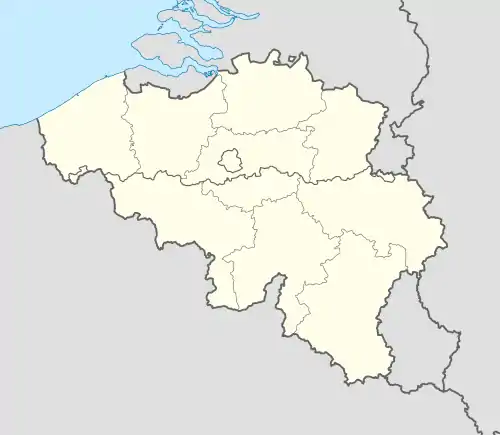 View of Tournai's Grand-Place from its Belfry | |
 Location within Belgium | |
| Location | Tournai, Hainaut, Belgium |
|---|---|
| Coordinates | 50°36′23″N 3°23′11″E / 50.60639°N 3.38639°E |
The Grand-Place (French: [ɡʁɑ̃ plas]; "Grand Square"[lower-alpha 1]) is the main square and the centre of activity of Tournai, Hainaut, Belgium. The square has a triangular shape, owing it to the convergence of several ancient paths,[2] and it covers 7,500 m2 (81,000 sq ft).
As in many Belgian cities, there are a number of cafés and pubs on the Grand-Place. In the middle of the square there are a series of water fountains, while a circular staircase to the top of the city's Belfry can be climbed.[3][4]
Buildings
On 16-17 May 1940, almost all the buildings in the center of Tournai, including the Grand Place, were destroyed by the German bombs.[5] They were rebuilt between the 1940s and the beginning of the 2000s, most of them in the same style.[6]
- The Belfry of Tournai, a freestanding bell tower of medieval origin, 72 metres (236 ft) in height with a 256-step stairway. Since 2005, it is recognised as a World Heritage Site by UNESCO, as part of the bi-national inscription "Belfries of Belgium and France" in recognition of its architecture and importance in the history of municipal power in Europe.[7]
- The Cloth Hall, a building originally constructed in 1610 in Renaissance style to replace a first 13th-century wooden hall. It was rebuilt identically in 1881 following its collapse.[8]
- The Church of St. Quentin, a Catholic parish church in Romanesque style with Gothic elements, known to have existed since the 10th century. The current building was built around 1200, but has been altered several times throughout history. It contains important sculptures by the 15th-century sculptor Jean Delemer.
- The Princess of Epinoy statue, a bronze statue made in 1863 by the sculptor Aimable Dutrieux in honour of Marie-Christine de Lalaing, who defended the city against Alexander Farnese, Duke of Parma, in 1581.

Panoramic view of the Grand-Place. From left to right: the Cloth Hall, the Rue des Maux, the Princess of Epinoy statue and the Church of Saint Quentin.
References
Footnotes
- ↑ In this case, the French word place is a "false friend", and the correct counterparts in English are "plaza" or "town square".[1]
Notes
Wikimedia Commons has media related to Grand'Place (Tournai).
- ↑ "place | Etymology, origin and meaning of place by Etymonline". www.etymonline.com. Retrieved 6 November 2021.
- ↑ itinari (3 October 2018). "Visit Grand-Place Tournai". itinari. Retrieved 10 March 2022.
- ↑ "The Grand Place". Visittournai. Retrieved 18 January 2023.
- ↑ "Tournai, le plus vieux Beffroi de Belgique". Visittournai (in French). Retrieved 16 January 2023.
- ↑ Colignon, Alain. "Guerre aérienne en Belgique (La)" (in French). Belgium WWII.
- ↑ "Tournai quasi détruite par les bombardements allemands et alliés lors de la Seconde Guerre mondiale" (in French). Notélé. 14 May 1922.
- ↑ Centre, UNESCO World Heritage. "Belfries of Belgium and France". UNESCO World Heritage Centre. Retrieved 18 January 2023.
- ↑ "The Cloth Hall - Tournai". Visittournai. Retrieved 18 January 2023.
This article is issued from Wikipedia. The text is licensed under Creative Commons - Attribution - Sharealike. Additional terms may apply for the media files.